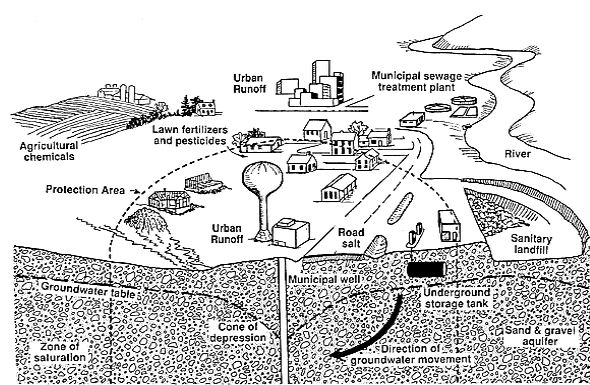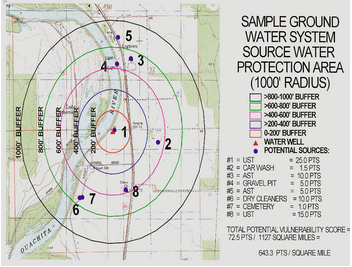On the Navajo Nation, groundwater is the source of drinking water for 99 percent of the population that is
served by a public water system. Groundwater is used for raising livestock, agriculture, and industry. In the
arid southwest, groundwater is a particular important resource because of the scarcity of surface water.
Although groundwater was once thought to be protected by layers of rock and soil, it is known that
groundwater is vulnerable to many types of contamination. Groundwater Under the Direct Influence
(GWUDI) of surface water are by default vulnerable to all types of contamination. Contaminants can enter
source waters from animal rangelands, illegal open dumps, waste storage lagoons, sewage and spectic
systems. Source waters can also be contaminated by chemical spills, open well casings, abandoned
wells, fertilizers, herbicides, pesticides, animal waste, and other sources. Community drinking water
systems are at risk from many possible contamination sources and no community wants to face the loss of
its drinking water.

As defined by the EPA, the Source Water Protection Area (SWPA) is the surface and subsurface area
surrounding the well, wellfield, springs, or surface water through which contaminants are likely to move
through and reach the source waters. There are four major components to the federally mandated SWAP
program. The NNEPA-PWSSP is to ensure the following requirements have been met for each regulated
public drinking water system:
1.Delineate Source Water Protection Area(s) (SWPA) for each source (i.e., well, spring, surface water
intake).
2.Inventory each SWPA for potential contaminant sources.
3.Conduct a susceptibility assessment for each drinking water source.
4.Make the findings of 1-3 readily available to interested parties.
The NNEPA-PWSSP is in good position to comply with these requirements. The NNEPA-PWSSP has been
assigned primacy for the federal drinking water program on the Navajo Nation. THE NNEPA-PWSSP is
responsible for implementing the SWAP requirements, including information dissemination.
CLICK HERE to view the Pollution Prevention - Susceptibility Assessment Survey Form.
CLICK HERE to view the Susceptibility Assessment "Update" Form.
The NNEPA-PWSSP's primary limitation in implementing SWAP requirements is the lack of disseminating the SWAP findings to interested parties in a simple, user-friendly format. As a result, the NNEPA-PWSSP is currently in the development stages with using geographic information system (GIS) applications to manage, store, and distribute this information by generating a computerized map. The NNEPA-PWSSP is also planning to develop applications that will allow interested parties to access the SWAP information through a Internet Mapping application, making it "secure, yet available."

The NNEPA-PWSSP is utilizing existing programs to implement the SWAP requirements. The Existing
programs which may yield successful implementation efforts include:
- Wellhead Protection
- Program
Phase II/V Monitoring Waiver Program
- Emergency Water Supply Program
- Consumer Confidence Report Program
- Design/Review Program
- GIS Mapping Project
All public water systems's Source Water and Protection Plans will be described in report format within the
following categories, each category equates to a chapter within the SWPP report:
- Physical and climate aspects of the water system
- Physcial description of the watershed
- Roles and duties of the agencies involved in Program Management
- Delineated Source Water Protection Area
- Inventory of potential contamination sources
- Management approaches to any potential contamination threats
- Review contingency plans for natural and man-made disasters
CLICK HERE for Navajo Nation Water Well Abandonment Requirements